The
Imperial Austrian Order of the Iron Crown
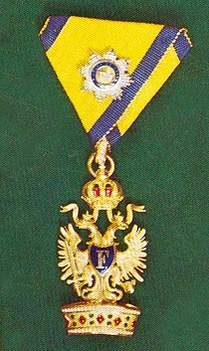 This most
impressive order was originally founded by Napoleon Bonaparte as
King Napoleon I of Italy on the 5th June 1805. Following
Napoleon's defeat and the incorporation of the province of
Lombardy by Austria the Order was reinstated on the 1st of
January 1816 in a new form. The Order was to be awarded in three
classes:
This most
impressive order was originally founded by Napoleon Bonaparte as
King Napoleon I of Italy on the 5th June 1805. Following
Napoleon's defeat and the incorporation of the province of
Lombardy by Austria the Order was reinstated on the 1st of
January 1816 in a new form. The Order was to be awarded in three
classes:
Knight 1st Class
|
20 Knights |
| Knight 2nd Class |
30 Knights |
| Knight 3rd Class |
50 Knights |
Additionally instituted on the 12th
February 1860 was a War Decoration to be incorporated within the
order for meritorious service in direct combat with the enemy.
This took the form of a Laurel wreath. Finally crossed Swords
were introduced in 1917 as a further distinction for personal
bravery before the enemy.
The Knights of the First Class received a sash of
yellow with narrow blue stripes on the outer edges with the Order
attached to the bow of the sash. The Order worn on the sash was
76mm in length and 45mm at its widest point. It consisted of the
a double headed Eagle and the actual Iron Crown. On the obverse
side was a Gold F within a blue shield. On the reverse side was a
similar shield with the numbers "1815". The sash which
was 102mm in width was worn from the right shoulder to the left
hip. They additionally received an eight pointed silver breast
star . In the centre was placed an Iron Crown on a gold field
surrounded by the motto AVITA ET AUCTA (Ancient and Extended) on
a dark blue ring. Until the18th July1884 the recipient of the 1st
Class Order would have been appointed a Privy Councillor. An
amendment to the Statutes of the Order dated the 6th of April
1908 introduced the "Kleine Dekoration" which was in
fact an every day version of the Order to be worn in service
dress. This took the form of a normal 3rd Class Order with a
miniature Star of the order placed on the triangular ribbon (see
illustration above).
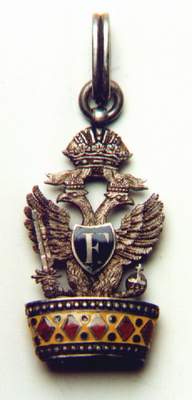 |
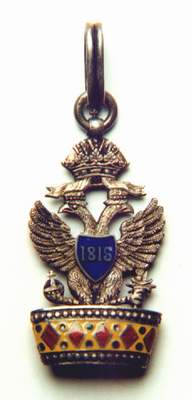 |
| Knight 3rd Class early
variant - obverse |
Knight 3rd Class early
variant - reverse |
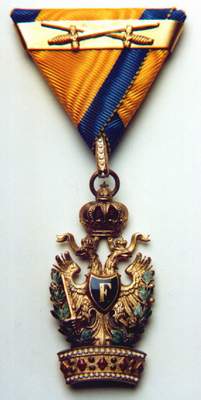 |
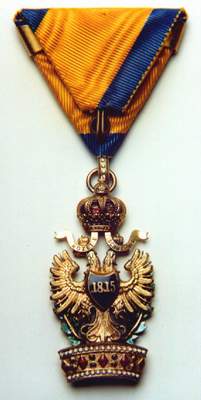 |
| Knight 3rd Class with War
Decoration and Swords and Bar - obverse |
Knight 3rd Class with War
Decoration and Swords and Bar - reverse |
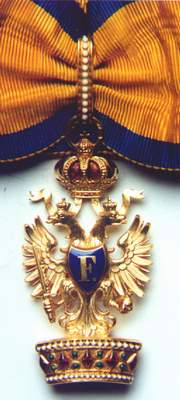 |
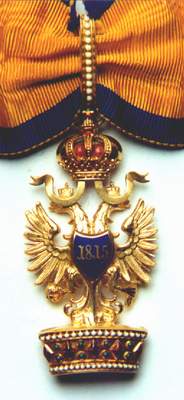 |
| Knight 2nd Class |
Knight 2nd Class |
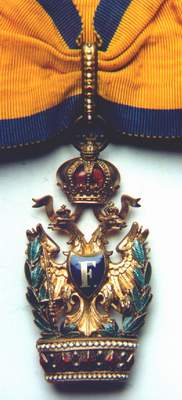 |
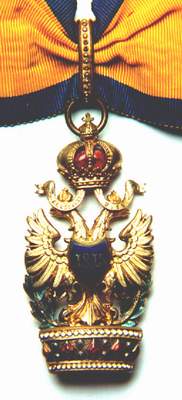 |
| Knight 2nd Class with War
Decoration - obverse |
Knight 2nd Class with War
Decoration - reverse |
|
|
| Knight 1st Class Breast
Star - early variant pre 1870 |
Feldzeugmeister Alexander
Freiherr von Krobatin wearing his EKO-R2 |
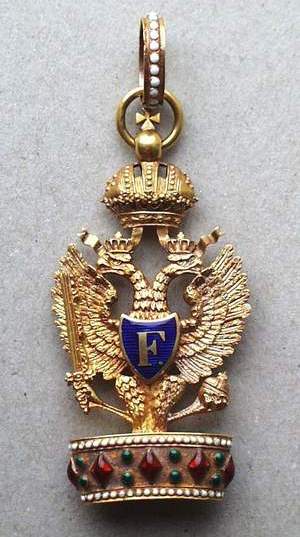 The Knights of
the Second Class wore the order at the throat on a neck ribbon of
yellow and blue stripes. The order excluding the ring was 66mm in
length and 34mm at its widest point. Similar to the 1st Class
Knights, a "Kleine Dekoration" was instituted for
Second Class Knights on the 27th October 1917. This took the form
of a miniature of the lower part of the crown worn on a
triangular ribbon. Until the18th July1884 the recipient of the
2nd Class Order would have been appointed a Freiherr or Baron in
the Austrian or Hungarian Nobility. A particularly fine example
of an early version of the Second Class order from about 1830
from the Enzo Calabresi collection is pictured to
the left.
The Knights of
the Second Class wore the order at the throat on a neck ribbon of
yellow and blue stripes. The order excluding the ring was 66mm in
length and 34mm at its widest point. Similar to the 1st Class
Knights, a "Kleine Dekoration" was instituted for
Second Class Knights on the 27th October 1917. This took the form
of a miniature of the lower part of the crown worn on a
triangular ribbon. Until the18th July1884 the recipient of the
2nd Class Order would have been appointed a Freiherr or Baron in
the Austrian or Hungarian Nobility. A particularly fine example
of an early version of the Second Class order from about 1830
from the Enzo Calabresi collection is pictured to
the left.
The Knights of the Third class wore a slightly smaller version
of the Order suspended from a triangular ribbon on the left
breast. The Order was 55mm high and 30mm at its widest point.
Until the18th July1884 the recipient of the 3rd Class Order would
have been appointed a Ritter or Knight in the Austrian or
Hungarian Nobility.
It should be noted that during the war the award tended to be
used very much as a bravery decoration for commissioned officers
as opposed to its original function as an Order for both
distinguished military and civil service. Already prior to the
war the number of Knights created far exceeded the originally
determined number of 100 and during the war itself thousands of
the awards were made and as an example 166 Third Class awards
were made to the three Landesschützen/Kaiserschützen Regiments
alone. One final point: There were many variations with regards
to the war decoration and or Swords. For example an Officer could
be made a Knight of the 1st Class without the War Decoration but
already be an holder of the Second Class with the War Decoration.
Of course he could be an holder of the War Decoration for both
Classes. It was also possible for an holder of an award to be
later awarded the Swords to his original Order. Therefore during
the period 1914-1918 the following variations could be
encountered:
| 1st Class Breast Star |
2nd Class Order with War
Decoration |
| 1st Class "Kleine
Dekoration" |
2nd Class "Kleine
Dekoration" with War Decoration |
| 1st Class Breast Star with
War Decoration |
2nd Class Order with War
Decoration of Lower Grade |
| 1st Class "Kleine
Dekoration" with War Decoration |
2nd Class "Kleine
Dekoration" with War Decoration of Lower Grade |
| 1st Class Breast Star with
War Decoration of Lower Grades |
2nd Class Order with War
Decoration and Golden Swords |
| 1st Class "Kleine
Dekoration" with War Decoration of Lower Grades |
2nd Class "Kleine
Dekoration" with War Decoration and Golden Swords |
| 1st Class Breast Star with
War Decoration and Golden Swords |
2nd Class Order with War
Decoration and Silver Swords |
| 1st Class "Kleine
Dekoration" with War Decoration and Golden Swords |
2nd Class "Kleine
Dekoration" with War Decoration and Silver Swords |
| 1st Class Breast Star with
War Decoration and Silver Swords |
2nd Class Order with a
Wreath for repeat awards |
| 1st Class "Kleine
Dekoration" with War Decoration and Silver Swords |
3rd Class Order |
| 2nd Class Order |
3rd Class Order with War
Decoration |
| 2nd Class "Kleine
Dekoration" |
3rd Class Order with War
Decoration and Swords |
Back to orders and
Decorations

 This most
impressive order was originally founded by Napoleon Bonaparte as
King Napoleon I of Italy on the 5th June 1805. Following
Napoleon's defeat and the incorporation of the province of
Lombardy by Austria the Order was reinstated on the 1st of
January 1816 in a new form. The Order was to be awarded in three
classes:
This most
impressive order was originally founded by Napoleon Bonaparte as
King Napoleon I of Italy on the 5th June 1805. Following
Napoleon's defeat and the incorporation of the province of
Lombardy by Austria the Order was reinstated on the 1st of
January 1816 in a new form. The Order was to be awarded in three
classes:







 The Knights of
the Second Class wore the order at the throat on a neck ribbon of
yellow and blue stripes. The order excluding the ring was 66mm in
length and 34mm at its widest point. Similar to the 1st Class
Knights, a "Kleine Dekoration" was instituted for
Second Class Knights on the 27th October 1917. This took the form
of a miniature of the lower part of the crown worn on a
triangular ribbon. Until the18th July1884 the recipient of the
2nd Class Order would have been appointed a Freiherr or Baron in
the Austrian or Hungarian Nobility. A particularly fine example
of an early version of the Second Class order from about 1830
from the Enzo Calabresi collection is pictured to
the left.
The Knights of
the Second Class wore the order at the throat on a neck ribbon of
yellow and blue stripes. The order excluding the ring was 66mm in
length and 34mm at its widest point. Similar to the 1st Class
Knights, a "Kleine Dekoration" was instituted for
Second Class Knights on the 27th October 1917. This took the form
of a miniature of the lower part of the crown worn on a
triangular ribbon. Until the18th July1884 the recipient of the
2nd Class Order would have been appointed a Freiherr or Baron in
the Austrian or Hungarian Nobility. A particularly fine example
of an early version of the Second Class order from about 1830
from the Enzo Calabresi collection is pictured to
the left.